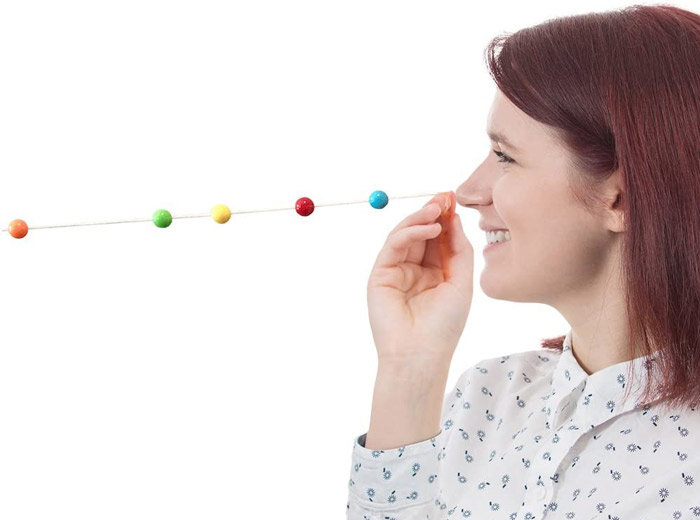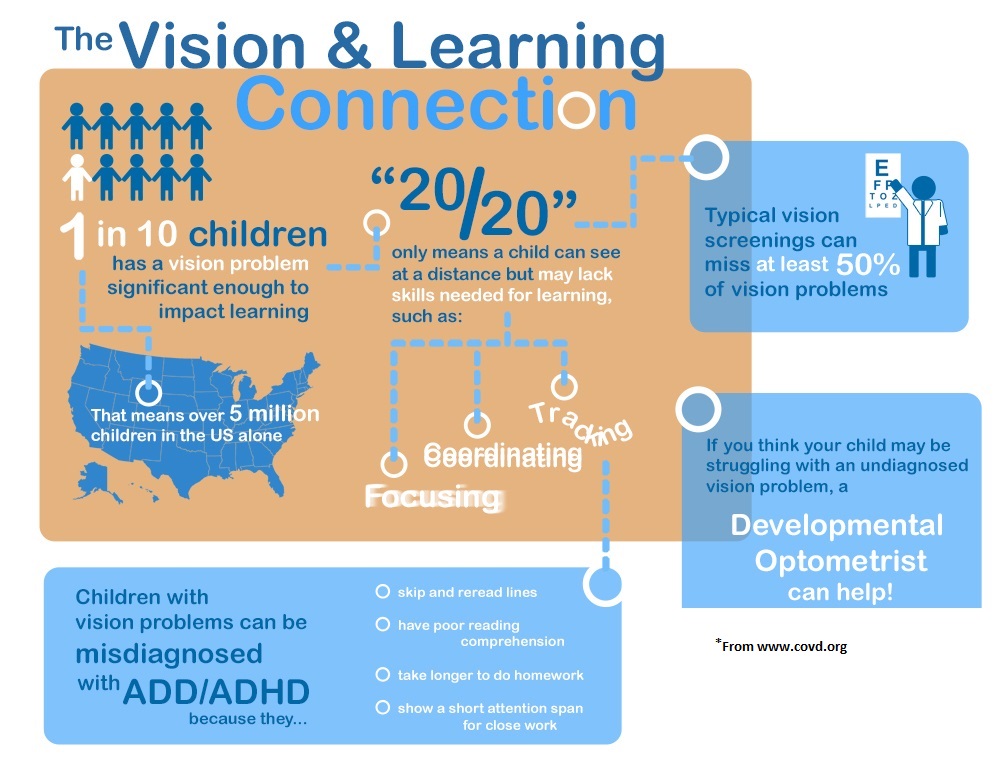Vision Therapy

Developmental Optometry and Vision Therapy at Nova Vision Center
The doctors and eye care professionals at Nova Vision Center provide developmental optometry and vision therapy for children and adults who have functional vision problems which prevent them from performing at their maximum potential and which may cause a variety of uncomfortable symptoms.
What is Developmental Optometry?
Developmental optometrists evaluate and diagnose functional vision problems in children and adults and provide specialized services to help them improve their visual function. They believe that vision can be developed and improved through a learned process. Effective visual function includes more than seeing 20/20, which is visual acuity. It encompasses the entire visual system.
What is Visual Function?
There are six major areas of visual function. During a comprehensive eye exam, our doctors perform tests to measure visual acuity and eye health. During a developmental evaluation, our doctors evaluate focusing ability, binocular vision, tracking, and visual perception.
Visual Acuity
Visual acuity is the clarity or sharpness of vision and is measured at 20 feet. If you are nearsighted, farsighted, have astigmatism, or an eye disease, these conditions will affect your visual acuity.
Eye Health
Healthy eyes are free of diseases, such as glaucoma, macular degeneration, and cataracts. Eye diseases affect visual acuity and overall visual function.
Focusing Ability
The eyes have an automatic focusing system which enables them to adjust the internal lens to see clearly at all distances, even when switching quickly between looking at nearby and then looking at something in the distance. If there is a problem with focusing ability, that visual problem is called accommodative dysfunction and can cause difficulty maintaining clear vision, visual discomfort and eye strain, fatigue, headaches, and more uncomfortable symptoms. Children who have accommodative dysfunction will understandably avoid reading and writing because they are uncomfortable.
Eye Coordination or Binocular Vision
Binocular vision is the ability to use information received through both eyes to create a single image. Individuals with binocular vision dysfunction struggle to see one clear image, and this leads to uncomfortable symptoms, including headaches, dizziness, double or overlapping vision, and problems with reading. Adults who have had a stroke or a concussion can develop binocular vision dysfunction. Children with strabismus or amblyopia also have binocular vision dysfunction.
Tracking
Visual tracking is the ability to control the eyes’ movements to maintain focus on a moving object and switching visual focus between two different objects.
Visual Perception
Visual perception is the brain’s ability to translate or make sense of what the eyes see. Even if an individual can see 20/20, that doesn’t necessarily mean they can process, interpret, and give meaning to what they are seeing.
Most of the time, we diagnose and treat functional vision problems in children because as fine motor control improves as people age, many learn to deal with functional vision problems on their own without treatment. Some people, though, including our own Dr. Dodge Perry, continue to need assistance and treatment well into adulthood for functional vision problems.
What are the Signs of a Functional Vision Problem?
Children who have a functional vision problem will not tell you they avoid reading because the words appear fuzzy when they try. They’ll simply avoid it altogether. Parents, teachers, and health care professionals should be aware of the signs of a functional vision problem in children so that the child can be referred to a developmental optometrist for an evaluation.
Signs include:
- Losing their place while reading
- Using a finger to keep one’s place while reading (beyond third grade)
- Substituting words with similar meaning or confusing words with similar letters
- Leaving endings off words
- Leaving out letters or substituting letters within words
- Not understanding the text or having difficulty following the plot or story line
- Headaches that occur during or within 20 minutes of reading
- Watery or painful eyes while reading
- Avoidance of recreational or pleasure reading
- Unusual postures while reading – turning the head, covering one eye, leaning very close to work
- Poor spelling because of omitting or substituting letters
- Difficulty reading out loud
Treatment for Functional Vision Problems
Treatment for functional vision problems may include custom lenses in the eyeglasses which contain a prism or bifocals. It may also include vision therapy.
How Vision Therapy Works
Visual therapy is a progressive program of vision procedures performed under doctor supervision in our office and is customized to the needs of the individual. We may also occasionally supplement vision therapy with procedures to be completed at home between sessions in our office.
Vision therapy can improve visual comfort and ease, increase visual efficiency and performance, and change how a patient processes or interprets visual information. Vision therapy often uses several types of specialized medical equipment such as therapeutic lenses, filters, occluders or patches, balance boards, and even fun activities on the computer.
RightEye Vision System™
We utilize the RightEye Vision System™ at Nova Vision Center to assess and illustrate possible deficiencies in reading and binocular vision issues, understand a child’s eye movements while they are reading, quantify reading comprehension and compare reading metrics against similar grade-level peers, and improve reading skills with an at-home vision training program.
Developmental Evaluation and Vision Therapy at Nova Vision Center
If you suspect your child may have a functional vision problem, schedule an appointment for a comprehensive eye exam and developmental evaluation with the doctors at Nova Vision Center.

